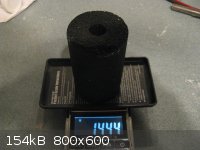
Boron Trioxide - 4-1-2013 at 16:05
The water filters that attach to your tap are actually carbon water filters. After opening one to find how the carbon looked it turned out to be a
large cylinder of very conductive carbon, something I would assume would be good for electrolysis. These are somewhat expensive to only use for
electrolysis, if you already use them to filter your water it seems a waste to discard them.
Dimensions
4.7 cm in diameter
7.4 cm height
1.2 cm hole diameter
144.4 g
Note: When cutting the plastic housing, a very bad smell was noticed, probably because this was a used filter, however the carbon itself doesn't seem
to smell at all.
Note 2: The best way I have found to attach an electrical connection is to very carefully hammer a nail or two in the the top.

99chemicals - 4-1-2013 at 16:11
Is it a reverse osmosis filter or just a regular filter? Can you find a pic or a website that sell them So we know what type/price range.
Boron Trioxide - 4-1-2013 at 17:47
This one is not a reverse osmosis, though that might work as well, here is a place to buy them, though I get mine from Superstore.
http://www.amazon.com/Brita-Replacement-Filters-2-Pack-White...
bbartlog - 4-1-2013 at 18:40
Nice find. I think I have some of these filters (used) and will have to try one as an electrode. I suspect that they are optimized for surface area /
porosity and as a result will probably be prone to crumbling (more so than regular graphite or obviously glassy carbon) but given that they're more or
less free if you use this kind of filter they could still be interesting.
Glucose Oxidase - 5-1-2013 at 00:42
not really bbartlog although you are right about the surface area optimization but it must be highly porous because it's supposed to trap particles in
its pores while filtrating water so if it is new it's probably highly porous but the main problem comes with the used ones because it is highly
contaminated with filtrates and will contaminate electrolytes used in.
